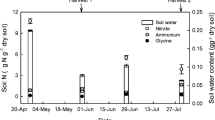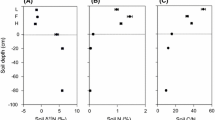Key message
Interspecific variation in nitrogen isotope composition of roots and leaves of tree seedlings grown in a steady-state nitrogen environment reflects known variation in sites of assimilation and nitrogen source preference in three tree species.
Abstract
As a time-integrated measure of nitrogen use, discrimination against the heavier stable isotope (15N) during the uptake and assimilation of inorganic nitrogen has the potential to provide information on interspecific differences in inorganic nitrogen source preference. Here, nitrogen isotope composition (δ15N) at natural abundance was measured for the roots and shoots from seedlings of three forest tree species: Populus tremuloides (aspen), Pinus contorta var. latifolia (pine) and Picea glauca (spruce). The seedlings were grown hydroponically with low (0.1 mM) or high (1.5 mM) concentrations of NO3 − or NH4 +, or in sand with NO3 −, NH4 + or an equal mix of NO3 − and NH4 + (0.1 mM). Whole-plant nitrogen isotope discrimination was observed in hydroponically grown seedlings but not in sand culture. Differences in δ15N between shoots and roots were greater in aspen when grown with NO3 − (3.02 ‰) than with NH4 + (1.27 ‰). There were no significant differences between the δ15N of leaves and roots for pine and spruce on either source. Although whole-plant nitrogen isotope discrimination was not observed in sand culture, shoot δ15N was, again, greater than root δ15N for NO3 −-grown aspen. Interspecific variation in nitrogen isotope discrimination was observed in both hydroponics and sand culture. The differences in nitrogen isotope composition under steady-state conditions indicate that interspecific differences in nitrogen source preference are consistent with previous experiments using alternative methods to identify differences in nitrogen uptake and assimilation in the same tree species.





Similar content being viewed by others
References
Andrews M (1986) The partitioning of nitrate assimilation between root and shoot of higher plants. Plant Cell Environ 9:511–519
Ariz I, Cruz C, Moran JF, González-Moro MB, García-Olaverri C, González-Murua C, Aparicio-Tejo PM (2011) Depletion of the heaviest stable N isotope is associated with NH4 +/NH3 toxicity in NH4 +-fed plants. BMC Plant Biol 11:83
Bauer D, Biehler K, Fock H, Carrayol E, Hirel B, Migge A, Becker TW (1997) A role for cytosolic glutamine synthetase in the remobilization of leaf nitrogen during water stress in tomato. Physiol Plant 99(2):241–248
Bedard-Haughn A, Van Groenigen JW, Van Kessel C (2003) Tracing 15N through landscapes: potential uses and precautions. J Hydrol 272(1):175–190
Bergersen FJ, Peoples MB, Turner GL (1988) Isotopic discriminations during the accumulation of nitrogen by soybeans. Funct Plant Biol 15(3):407–420
Britto DT, Siddiqi MY, Glass AD, Kronzucker HJ (2001) Futile transmembrane NH4+ cycling: a cellular hypothesis to explain ammonium toxicity in plants. PNAS 98(7):4255–4258
Cawse PA (1967) The determination of nitrate in soil solution by ultraviolet spectrometry. Analyst 92:311–315
Comstock J (2001) Steady-state isotopic fractionation in branched pathways using plant uptake of NO3 – as an example. Planta 214(2):220–234. doi:10.1007/s004250100602
Dijkstra P, Williamson C, Menyailo O, Doucett R, Koch G, Hungate BA (2003) Nitrogen stable isotope composition of leaves and roots of plants growing in a forest and a meadow. Isotopes Environ Health Stud 39:29–39
Evans RD (2001) Physiological mechanisms influencing plant nitrogen isotope composition. Trends Plant Sci 6(3):121–126
Evans RD, Bloom AJ, Sukrapanna SS, Ehleringer JR (1996) Nitrogen isotope composition of tomato (Lycopersicon esculentum Mill. cv. T-5) grown under ammonium or nitrate nutrition. Plant Cell Environ 19(11):1317–1323. doi:10.1111/j.1365-3040.1996.tb00010.x
Gessler A, Rienks M, Rennenberg H (2000) NH3 and NO2 fluxes between beech trees and the atmosphere—correlation with climatic and physiological parameters. New Phytol 147:539–560
Glass ADM, Britto DT, Kaiser BN et al (2002) The regulation of nitrate and ammonium transport systems in plants. J Exp Bot 53:855–864
Handley LL, Raven JA (1992) The use of natural abundance of nitrogen isotopes in plant physiology and ecology. Plant Cell Environ 15:965–985
Högberg P, Johannisson C, Högberg MN (2014) Is the high 15N natural abundance of trees in N-loaded forests caused by an internal ecosystem N isotope redistribution or a change in the ecosystem N isotope mass balance? Biogeochem 117:351–358
Husted S, Schjoerring JK, Nielsen KH, Nemitz E, Sutton MA (2000) Stomatal compensation points for ammonia in oilseed rape plants under field conditions. Agric For Meterol 105(4):371–383
Johnson JE, Berry JA (2013) The influence of leaf-atmosphere NH3 (g) exchange on the isotopic composition of nitrogen in plants and the atmosphere. Plant Cell Environ 36(10):1783–1801
Johnson CM, Stout PR, Broyer TC, Carlton AB (1957) Comparative chlorine requirements of different plant species. Plant Soil 8:337–353
Kalcsits L, Guy RD (2013a) Whole plant and organ level nitrogen isotope discrimination indicates modification of partitioning of assimilation, fluxes and allocation of nitrogen in knockout lines of Arabidopsis thaliana. Physiol Plant 149:249–259
Kalcsits LA, Guy RD (2013b) Quantifying remobilization of pre-existing nitrogen from cuttings to new growth of woody plants using 15N at natural abundance. Plant Methods 9:27
Kalcsits LA, Buschhaus HA, Guy RD (2014) Nitrogen isotope discrimination as an integrated measure of nitrogen fluxes, assimilation and allocation in plants. Physiol Plant 151(3):293–304
Karsh KL, Granger J, Kritee K, Sigman DM (2014) Eukaryotic assimilatory nitrate reductase fractionates N and O isotopes with a ratio near unity. Environ Sci Technol 46:5727–5735
Kolb KJ, Evans RD (2003) Influence of nitrogen source and concentration on nitrogen isotopic discrimination in two barley genotypes (Hordeum vulgare L.). Plant Cell Environ 3:1431–1440
Kronzucker HJ, Siddiqi MY, Glass AD (1997) Conifer root discrimination against soil nitrate and the ecology of forest succession. Nature 385(6611):59–61
Li H, Li M, Luo J, Cao X, Qu L, Gai Y, Luo ZB (2012) N-fertilization has different effects on the growth, carbon and nitrogen physiology, and wood properties of slow-and fast-growing Populus species. J Exp Bot 63(17):6173–6185
Luo J, Li H, Liu T, Polle A, Peng C, Luo ZB (2013) Nitrogen metabolism of two contrasting poplar species during acclimation to limiting nitrogen availability. J Exp Bot 64(14):4207–4224
Min X, Siddiqi MY, Guy RD, Glass ADM, Kronzucker HJ (1998) Induction of nitrate uptake and nitrate reductase activity in trembling aspen and lodgepole pine. Plant Cell Environ 21(10):1039–1046
Min X, Siddiqi MY, Guy RD, Glass ADM, Kronzucker HJ (1999) A comparative study of fluxes and compartmentation of nitrate and ammonium in early-successional tree species. Plant Cell Environ 22(7):821–830
Min X, Siddiqi MY, Guy RD, Glass ADM, Kronzucker HJ (2002) A comparative study of fluxes and compartmentation of nitrate and ammonium in early-successional tree species. Plant Cell Environ 22:821–830
Peuke AD (2010) Correlations in concentrations, xylem and phloem flows, and partitioning of elements and ions in intact plants. A summary and statistical re-evaluation of modelling experiments in Ricinus communis. J Exp Bot 61:635–655
Peuke AD, Gessler A, Rennenberg H (2006) The effect of drought on C and N stable isotopes in different fractions of leaves, stems and roots of sensitive and tolerant beech ecotypes. Plant Cell Environ 29(5):823–835. doi:10.1111/j.1365-3040.2005.01452.x
Peuke AD, Gessler A, Tcherkez G (2013) Experimental evidence for diel δ15N-patterns in different tissues, xylem and phloem saps of castor bean (Ricinus communis L.). Plant Cell Environ 36:2219–2228
Prescott CE, Hope GD, Blevins LL (2003) Effect of gap size on litter decomposition and soil nitrate concentrations in a high-elevation spruce fir forest. Can J For Res 33(11):2210–2220
Pritchard ES, Guy RD (2005) Nitrogen isotope discrimination in white spruce fed with low concentrations of ammonium and nitrate. Trees Struct Funct 19:89–98
Robinson D (2001) δ15N as an integrator of the nitrogen cycle. Trends Ecol Evol 16(3):153–162. doi:10.1016/S0169-5347(00)02098-X
Schjoerring JK, Husted S, Mack G, Mattson M (2002) The regulation of ammonium translocation in plants. J Exp Bot 53:883–890
Solorzano L (1969) Determination of ammonia in natural waters by the phenol-hypochlorite method. Limnol Oceanogr 1969(14):799–801
Tcherkez G, Hodges M (2008) How stable isotopes may help to elucidate primary nitrogen metabolism and its interaction with (photo) respiration in C(3) leaves. J Exp Bot 59:1685–1693
Waser NA, Yu Z, Yin K, Nielsen B, Harrison PJ, Turpin DH, Calvert SE (1999) Nitrogen isotopic fractionation during a simulated diatom spring bloom: importance of N-starvation in controlling fractionation. Marine Ecol Prog Ser 179:291–296
Author contribution statement
LAK participated in data analysis and interpretation and drafted the manuscript. XJM participated in experimental design and conducted the experiments. RDG conceived and oversaw the study, participated in analysis and interpretation, and edited the final version of the manuscript.
Acknowledgments
This work was funded by a Natural Sciences and Engineering Research Council of Canada (NSERC) Discovery Grant to RDG. LAK was supported by a NSERC Vanier Canada Graduate Scholarship.
Conflict of interest
The authors declare that the research was conducted in the absence of any commercial or financial relationships that could be construed as a potential conflict of interest.
Author information
Authors and Affiliations
Corresponding author
Additional information
Communicated by A. Gessler.
Rights and permissions
About this article
Cite this article
Kalcsits, L.A., Min, X. & Guy, R.D. Interspecific variation in leaf–root differences in δ15N among three tree species grown with either nitrate or ammonium. Trees 29, 1069–1078 (2015). https://doi.org/10.1007/s00468-015-1186-3
Received:
Revised:
Accepted:
Published:
Issue Date:
DOI: https://doi.org/10.1007/s00468-015-1186-3




